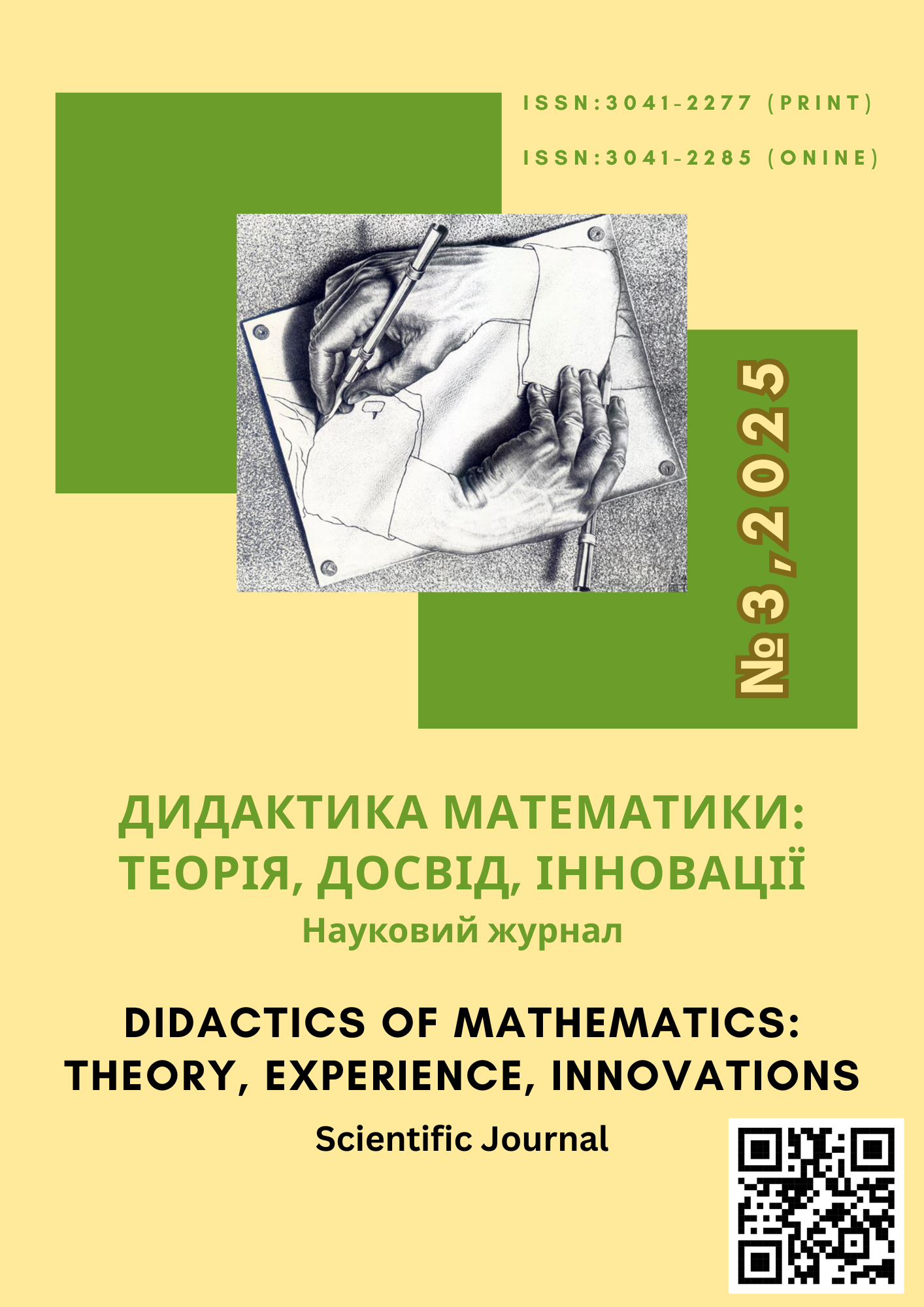Нigher mathematics at a technical university: a study of students' attitudes to bilingual learning
https://doi.org/10.31652/3041-2277-2025-3-31-43Published 2025-07-15
Keywords
- bilingual teaching/learning,
- higher mathematics,
- foreign language education,
- subject-oriented bilingual didactic models
Copyright (c) 2025 Наталія Сніжко

This work is licensed under a Creative Commons Attribution 4.0 International License.
How to Cite
Abstract
Changing paradigms of higher education, the challenges of globalization require a review of methods and approaches to training future specialists in Ukrainian universities. One of the modern requirements is the training of a specialist capable of working in a multicultural environment. Bilingual education meets this goal. In the process of bilingual teaching/learning, a foreign language is a means of mastering special disciplines, including mathematics.
The aim of the work is to analyze the results of a study of students' attitudes to a bilingual higher mathematics course. A survey was conducted among 89 students of the Electrical Engineering Faculty, National University Zaporizhzhia Polytechnic (both those who studied a bilingual course and those who studied a traditional course). The questionnaires contained multiple-choice questions, single-choice questions, open-ended questions, and questions using the Likert rating scale.
The results of the study indicate the interest of students in the bilingual course, their motivation to study higher mathematics in English. At the same time, the main problems that arise for students in the process of learning mathematics in a foreign language and the factors that can affect the effectiveness of bilingual mathematics learning have been identified. Possible ways to solve these problems were outlined. Taking into account the results of the study, recommendations are given for the implementation of a bilingual course on higher mathematics at a technical university.
The results obtained can be the basis for further research to assess the influence of the bilingual teaching/learning factor on the acquisition of subject-specific mathematical knowledge for future engineers.
Downloads
References
- Airey, J., Lauridsen, K. M., Räsänen, A., Salö, L., & Schwach, V. (2017). The expansion of English-medium instruction in the Nordic countries: Can top-down university policies encourage bottom-up disciplinary literacy goals? Higher Education, 73(4), 561–576. https://doi.org/10.1007/s10734-015-9950-2
- Airey, J. (2013). “I don’t teach language”. The linguistic attitudes of physics lecturers in Sweden. AILA Review, 25(1), 64–79. https://doi.org/10.1075/aila.25.05air
- Baker, W., & Hüttner, J. (2017). English and more: A multisite study of roles and conceptualisations of language in English medium multilingual universities from Europe to Asia. Journal of Multilingual and Multicultural Development, 38(6), 501–516. https://doi.org/10.1080/01434632.2016.1207183
- Balula, A., Vasconcelos, S., & Moreira, A. (2019). Developing academic skills in blended environments. Journal of Teaching English for Specific and Academic Purposes, 7(3), 303–309. https://doi.org/10.22190/JTESAP1903303B
- Bolitho, R., & West, R. (2017). The internationalisation of Ukrainian universities: The English language dimension. Stal.
- Dearden, J. (2014). English medium instruction: A growing global phenomenon. British Council. https://www.teachingenglish.org.uk
- Fenton-Smith, B., Humphreys, P., & Walkinshaw, I. (Eds.). (2017). English medium instruction in higher education in Asia-Pacific. Springer.
- Galloway, N., & Rose, H. (2021). English medium instruction and the English language practitioner. ELT Journal, 75(1), 33–41. https://doi.org/10.1093/elt/ccaa063
- Goodman, B. A. (2014). Implementing English as a medium of instruction in a Ukrainian University: Challenges, adjustments, and opportunities. International Journal of Pedagogies and Learning, 9(2), 130–141. https://doi.org/10.1080/18334105.2014.11082026
- Kırkgöz, Y., & Dikilitaş, K. (Eds.). (2018). Key issues in English for specific purposes in higher education. Springer.
- Klaassen, R. G. (2001). The international university curriculum: Challenges in English-medium engineering education (Doctoral dissertation, Technische Universiteit Delft). https://doi.org/10.4233/uuid:dea78484-b8c2-40d0-9677-6a508878e3d9
- Kováčiková, E., & Luprichová, J. (2023). CLIL as the vehicle of transition from mono- to bilingual instruction at Slovak universities. Journal of Teaching English for Specific and Academic Purposes, 11(3), 753–763. https://doi.org/10.22190/JTESAP231003056K
- Maiworm, F., & Wächter, B. (Eds.). (2002). English-language-taught degree programmes in European higher education: Trends and success factors. Lemmens Verlags & Mediengesellschaft.
- Macaro, E., Curle, S., Pun, J., An, J., & Dearden, J. (2018). A systematic review of English medium instruction in higher education. Language Teaching, 51(1), 36–76. https://doi.org/10.1017/s0261444817000350
- Pérez-Cañado, M. L. (2012). CLIL research in Europe: Past, present, and future. International Journal of Bilingual Education and Bilingualism, 15(3), 315–341. https://doi.org/10.1080/13670050.2011.630064
- Sandstrom, A.-M. (2018). English-taught Bachelor’s programs in Europe. International Higher Education, (96), 12–13. https://doi.org/10.6017/ihe.2019.96.10775
- Snizhko, N. (2023). Implementation of bilingual education in Ukrainian institutions of higher education. Viae Educationis: Studies of Education and Didactics, 2(3), 35–39. https://doi.org/10.15804/ve.2023.03.04
- Vinke, A. A., Snippe, J., & Jochem, W. (1998). English-medium content courses in non-English higher education: A study of lecturer experiences and teaching behaviours. Teaching in Higher Education, 3(3), 383–394. https://doi.org/10.1080/1356215980030307
- Wächter, B., & Maiworm, F. (Eds.). (2014). English-taught programmes in European higher education: The state of play in 2014. LemmensMedien GmbH.

